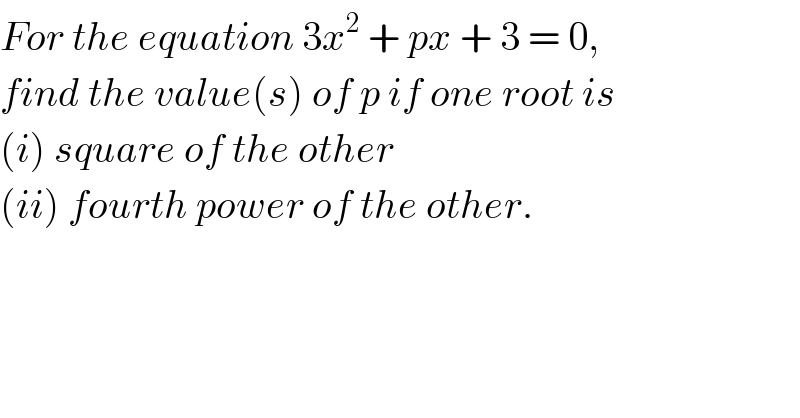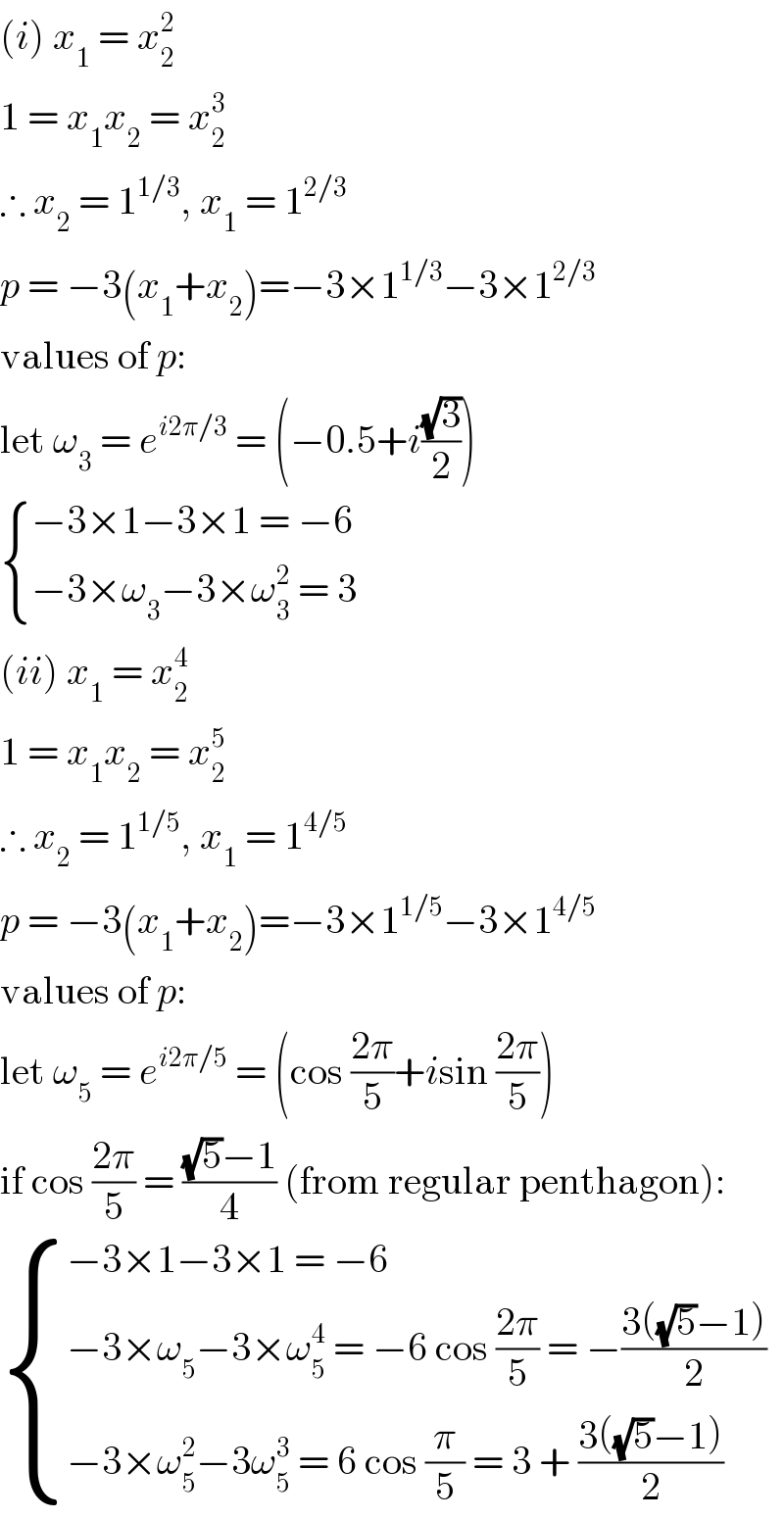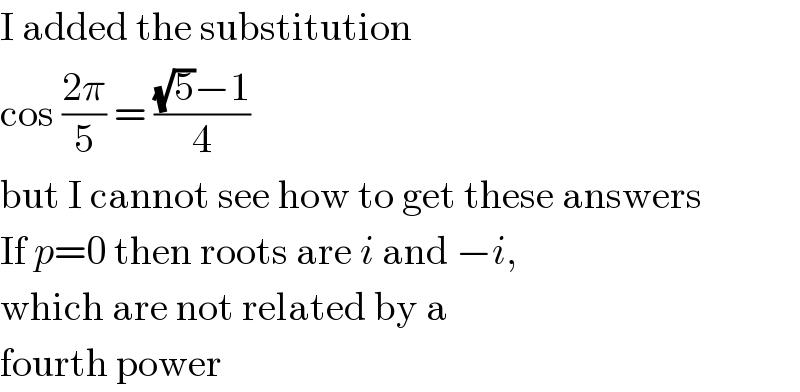
Question Number 20670 by Tinkutara last updated on 31/Aug/17

$${For}\:{the}\:{equation}\:\mathrm{3}{x}^{\mathrm{2}} \:+\:{px}\:+\:\mathrm{3}\:=\:\mathrm{0}, \\ $$$${find}\:{the}\:{value}\left({s}\right)\:{of}\:{p}\:{if}\:{one}\:{root}\:{is} \\ $$$$\left({i}\right)\:{square}\:{of}\:{the}\:{other} \\ $$$$\left({ii}\right)\:{fourth}\:{power}\:{of}\:{the}\:{other}. \\ $$
Answered by dioph last updated on 31/Aug/17

$$\left({i}\right)\:{x}_{\mathrm{1}} \:=\:{x}_{\mathrm{2}} ^{\mathrm{2}} \\ $$$$\mathrm{1}\:=\:{x}_{\mathrm{1}} {x}_{\mathrm{2}} \:=\:{x}_{\mathrm{2}} ^{\mathrm{3}} \\ $$$$\therefore\:{x}_{\mathrm{2}} \:=\:\mathrm{1}^{\mathrm{1}/\mathrm{3}} ,\:{x}_{\mathrm{1}} \:=\:\mathrm{1}^{\mathrm{2}/\mathrm{3}} \\ $$$${p}\:=\:−\mathrm{3}\left({x}_{\mathrm{1}} +{x}_{\mathrm{2}} \right)=−\mathrm{3}×\mathrm{1}^{\mathrm{1}/\mathrm{3}} −\mathrm{3}×\mathrm{1}^{\mathrm{2}/\mathrm{3}} \\ $$$$\mathrm{values}\:\mathrm{of}\:{p}: \\ $$$$\mathrm{let}\:\omega_{\mathrm{3}} \:=\:{e}^{{i}\mathrm{2}\pi/\mathrm{3}} \:=\:\left(−\mathrm{0}.\mathrm{5}+{i}\frac{\sqrt{\mathrm{3}}}{\mathrm{2}}\right) \\ $$$$\begin{cases}{−\mathrm{3}×\mathrm{1}−\mathrm{3}×\mathrm{1}\:=\:−\mathrm{6}}\\{−\mathrm{3}×\omega_{\mathrm{3}} −\mathrm{3}×\omega_{\mathrm{3}} ^{\mathrm{2}} \:=\:\mathrm{3}}\end{cases} \\ $$$$\left({ii}\right)\:{x}_{\mathrm{1}} \:=\:{x}_{\mathrm{2}} ^{\mathrm{4}} \\ $$$$\mathrm{1}\:=\:{x}_{\mathrm{1}} {x}_{\mathrm{2}} \:=\:{x}_{\mathrm{2}} ^{\mathrm{5}} \\ $$$$\therefore\:{x}_{\mathrm{2}} \:=\:\mathrm{1}^{\mathrm{1}/\mathrm{5}} ,\:{x}_{\mathrm{1}} \:=\:\mathrm{1}^{\mathrm{4}/\mathrm{5}} \\ $$$${p}\:=\:−\mathrm{3}\left({x}_{\mathrm{1}} +{x}_{\mathrm{2}} \right)=−\mathrm{3}×\mathrm{1}^{\mathrm{1}/\mathrm{5}} −\mathrm{3}×\mathrm{1}^{\mathrm{4}/\mathrm{5}} \\ $$$$\mathrm{values}\:\mathrm{of}\:{p}: \\ $$$$\mathrm{let}\:\omega_{\mathrm{5}} \:=\:{e}^{{i}\mathrm{2}\pi/\mathrm{5}} \:=\:\left(\mathrm{cos}\:\frac{\mathrm{2}\pi}{\mathrm{5}}+{i}\mathrm{sin}\:\frac{\mathrm{2}\pi}{\mathrm{5}}\right) \\ $$$$\mathrm{if}\:\mathrm{cos}\:\frac{\mathrm{2}\pi}{\mathrm{5}}\:=\:\frac{\sqrt{\mathrm{5}}−\mathrm{1}}{\mathrm{4}}\:\left(\mathrm{from}\:\mathrm{regular}\:\mathrm{penthagon}\right):\: \\ $$$$\begin{cases}{−\mathrm{3}×\mathrm{1}−\mathrm{3}×\mathrm{1}\:=\:−\mathrm{6}}\\{−\mathrm{3}×\omega_{\mathrm{5}} −\mathrm{3}×\omega_{\mathrm{5}} ^{\mathrm{4}} \:=\:−\mathrm{6}\:\mathrm{cos}\:\frac{\mathrm{2}\pi}{\mathrm{5}}\:=\:−\frac{\mathrm{3}\left(\sqrt{\mathrm{5}}−\mathrm{1}\right)}{\mathrm{2}}}\\{−\mathrm{3}×\omega_{\mathrm{5}} ^{\mathrm{2}} −\mathrm{3}\omega_{\mathrm{5}} ^{\mathrm{3}} \:=\:\mathrm{6}\:\mathrm{cos}\:\frac{\pi}{\mathrm{5}}\:=\:\mathrm{3}\:+\:\frac{\mathrm{3}\left(\sqrt{\mathrm{5}}−\mathrm{1}\right)}{\mathrm{2}}\:}\end{cases} \\ $$
Commented by Tinkutara last updated on 31/Aug/17

$$\mathrm{Thanks}\:\mathrm{for}\:\left({i}\right)\:\mathrm{part}. \\ $$$$\mathrm{But}\:\mathrm{in}\:\left({ii}\right)\:\mathrm{part},\:\mathrm{answer}\:\mathrm{is}\:\mathrm{0}\:\mathrm{and} \\ $$$$\frac{\mathrm{3}\left(\sqrt{\mathrm{5}}\:−\:\mathrm{1}\right)}{\mathrm{2}}.\:\mathrm{Can}\:\mathrm{you}\:\mathrm{get}\:\mathrm{it}? \\ $$
Commented by dioph last updated on 31/Aug/17

$$\mathrm{I}\:\mathrm{added}\:\mathrm{the}\:\mathrm{substitution} \\ $$$$\mathrm{cos}\:\frac{\mathrm{2}\pi}{\mathrm{5}}\:=\:\frac{\sqrt{\mathrm{5}}−\mathrm{1}}{\mathrm{4}} \\ $$$$\mathrm{but}\:\mathrm{I}\:\mathrm{cannot}\:\mathrm{see}\:\mathrm{how}\:\mathrm{to}\:\mathrm{get}\:\mathrm{these}\:\mathrm{answers} \\ $$$$\mathrm{If}\:{p}=\mathrm{0}\:\mathrm{then}\:\mathrm{roots}\:\mathrm{are}\:{i}\:\mathrm{and}\:−{i}, \\ $$$$\mathrm{which}\:\mathrm{are}\:\mathrm{not}\:\mathrm{related}\:\mathrm{by}\:\mathrm{a}\: \\ $$$$\mathrm{fourth}\:\mathrm{power} \\ $$
Commented by Tinkutara last updated on 31/Aug/17

$$\mathrm{Thank}\:\mathrm{you}\:\mathrm{very}\:\mathrm{much}\:\mathrm{Sir}! \\ $$
